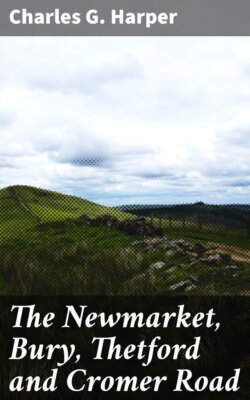Читать книгу The Newmarket, Bury, Thetford and Cromer Road - Charles G. Harper - Страница 17
На сайте Литреса книга снята с продажи.
X
ОглавлениеTable of Contents
Bishop’s Stortford is a pleasant and an old-fashioned market-town, with a great and fussy air of business, a long High Street running in the valley near, and parallel with, the Stort, and a large parish church perched on the shoulder of a precipitous street most picturesquely and accurately named Windhill. Natives have long since dropped the first half of the name and know it as “Stortford,” except indeed when they say “Strawford,” as very often they do.
WINDHILL, BISHOP’S STORTFORD.
There was, once upon a time, a fine strong and damp castle in the Stort meadows, midway between the town and its suburb of Hockerill, a stronghold of the Bishops of London from the time of William the Conqueror, but it has long since disappeared and only a green, tree-covered mound remains. Its name was Waytemore, a name with a suspicion of grim humour about it, traditions still tell how the zealous Bonner imprisoned many a heretic here, before burning them at the stake; but the martyrs suffered and went to Heaven, and the Bishop to Hell, so long since that it is difficult to probe the truth of the stories.
HENRY GILBEY.
There are old and quaint inns in the town; the “Black Lion” the most ancient, and certainly at this time the most picturesque of them, but the “Boar’s Head,” on Windhill, is little less so; and, moreover, grouping finely with that parish church already named, makes a picture. It is a great church and a fine one, even though that tall spire be poor Gothic and its four satellite pinnacles abjectly bad. Up to the present the church contains no memorial to Rhodes, but students of coaching history find interest in the polished Aberdeen granite stone in the churchyard, in memory of Henry Gilbey, father of Sir Walter Gilbey, Bart. The inscription runs:—
HENRY GILBEY
OF THIS TOWN, MANY YEARS COACH PROPRIETOR,
DIED SEPTEMBER 29TH, 1842,
AGED 52 YEARS.
There are even yet a few ancients in Bishop’s Stortford who remember “old Harry Gilbey,” as they call him, and speak of him as in partnership with one William Low, of Saffron Walden, in the coach running between that place, Bishop’s Stortford, and London. This coach was taken over by Henry Gilbey, as sole proprietor, shortly after 1824. Besides this—the “Old Stortford Coach,” as it was called—he had another, running between the “George,” Bishop’s Stortford, and London. Both called at the “Crown,” Hockerill, a house demolished in 1903, and went to and returned from the “Bull,” Aldgate, until 1841, when the railway was opened to Bishop’s Stortford.
HOCKERILL.
Henry Gilbey, who was son of Daniel Gilbey, proprietor of the “White Bear,” Stansted, was born January 29th, 1789. He married, at the age of 25, in 1814. From 1829 he resided at the house, still standing, called “The Links,” on Windhill, where the future Sir Walter Gilbey was born, in 1831.
THE “CROWN,” HOCKERILL. DEMOLISHED 1903.
From a drawing by P. Palfrey.
